In some Metro Manila communities, fires are a way of life
The gymnasium in Welfareville Compound in Barangay Addition Hills, Mandaluyong City, continues to house more than 1,000 families, victims of a huge fire that hit the area as early as November last year.
“Pagsigaw ng sunog, takbo na ako agad. Yun lang ang nadala ko, anak ko lang,” Gina Campos told GMA News.
“Darating naman talaga yan kung talagang darating kaya hindi na namin pinaghahandaan," she added.
It was the second fire in Welfareville for Campos, a compound resident and one of the evacuees. In both cases, she barely saved any personal belongings.
Welfareville, a government property, has been hit by at least 20 fires in the last decade. In 2012 alone, it was razed seven times.
The November 13 fire last year had been the biggest in terms of casualties and damage: two were killed and an estimated P10 million worth of property went up in smoke.
Four other residential areas suffered multiple fires over the last decade, from 2006 to 2016, GMA News Research's data showed.
These are Parola Compound and Baseco Compound, both in Manila; and Agham Road and NIA Road, both in Quezon City.
Considered slums, the communities are densely populated and beset with poor living conditions and fire hazards.
These include houses made of light and highly flammable materials, illegal electrical connections or, in the absence of electricity, the use of candles.
Thus, fires have become a fact of life for residents of these areas like Campos, who has come to accept the likely chance of her house getting burned down.
Malu Felizar-Cagay of the Center for Disaster Preparedness said the local government units have the responsibility not only to prevent fires but also to prepare for such contingencies.
“BFP primarily is pamatay sunog. Maaari ding makatulong mag-raise ng public awareness. Pero sa LGUs nakasalalay. Paano ba mapo-protektahan ang mga tao?" Cagay said.
"Sila ang dapat magpa-facilitate at gumawa ng mga disaster contingency plan. Nakikita ito (sa slum areas) ang lalim ng kahirapan. It takes political commitment from the government na alisin ang mga tao sa lugar na mapanganib,” she added.
Over the last decade, fires have claimed at least 813 lives in Metro Manila. Some 2,794 were injured, 88 percent of them civilians.

64 fires hit five communities in a decade
Welfareville had the biggest number of fires in the last decade—an average of two fires per year. The 20 fires recored over the period at Welfareville killed three, wounded nine and destroyed a total of P12 million in property.
Parola had 16 fires since 2006, or more than one fire per year, wounding three and damaging P4.5 million. Nearby Baseco had 11, where at least one person died.
Agham Road, where the BFP national headquarters is located, had 13 fires that in total injured two and destroyed P10 million.
NIA Road had four major fires since 2006 that killed a total of five people and injured 14. In November 2011, three children and a woman were killed.
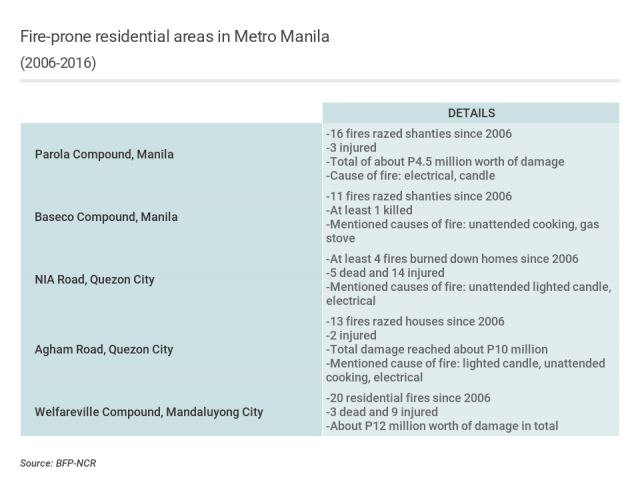
Mandaluyong
Mandaluyong City is the second most densely populated city in Metro Manila, after Manila. Based on the 2015 census data, there are about 41,000 residents per square kilometer in Mandaluyong. Barangay Addition Hills, where Welfareville is located, is the 10th most populous barangay in NCR.
Half of the 20 fires in Welfareville that required BFP assistance reached the alarm and task force levels, which means more than one firetruck . The fire in November last year reached general alarm—the highest fire alarm level requiring the assistance of all available firetrucks.
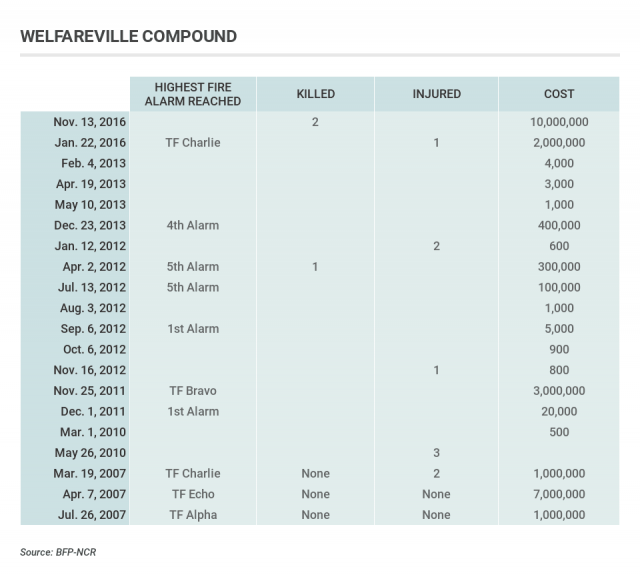
Manila
Data from the Metro Manila Development Authority show that Manila is second in terms of number of informal settlers, with 100,000 families in 2010.
Philippine Statistics Authority figures show that Manila was the most densely populated among the highly urbanized cities in the National Capital Region.
There are about 71,000 persons per square kilometer in Manila based on the 2015 data from PSA.
Parola and Baseco compounds, both located on the fringe of the city, are two of the major urban poor communities in Manila.
Parola had the most fires during the decade in the years 2010 and 2011.
Four fires struck the area in each of those two years. Three hit the area in each of the years 2008 and 2013.
Just last month, February 2017, a 10-hour fire again razed Parola, leaving at least 1,000 families homeless.
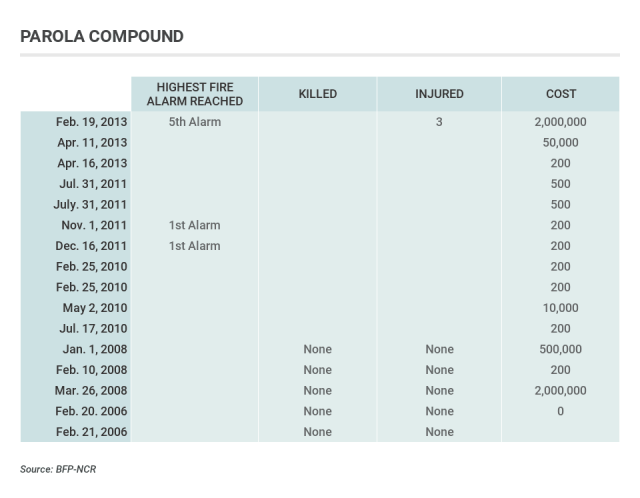
Baseco’s most recent fire happened just a few days before Christmas in 2016. Twenty-seven families were left homeless.
Of the 11 fires that razed the compound between 2006 and 2016, seven reached the alarm and task force levels. There were five fires in Baseco in 2010. In 2011, four fires hit the area.

Quezon City
Two other slum areas frequently threatened by fires are in Quezon City, the biggest city in Metro Manila in terms of land area. Quezon City is about 160 square kilometers wide and is about four times bigger than Manila.
It has more than 220,000 informal settler families, equivalent to 40 percent of such families in Metro Manila in 2010, MMDA data show.
The local government also noted the Agham Road and NIA Road, being near government lands, naturally attract informal settlers from neighboring cities. These two areas are within one kilometer from each other.
The four big fires that destroyed shanties along NIA road from 2011 to 2016 were the deadliest among the fires that happened in the five fire-ridden areas .
The most recent fire-related death happened two days after Christmas last year. The fire killed an elderly woman.
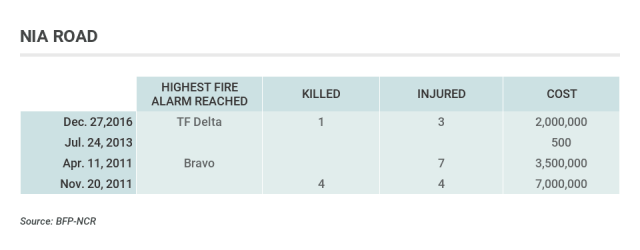
To date, Agham Road has been razed by at least 13 fire incidents. The most recent fire in the area happened in April 2012, which razed about P3 million worth of property.
Informal settlers in Agham Road are facing relocation as the site is being cleared for commercial use.
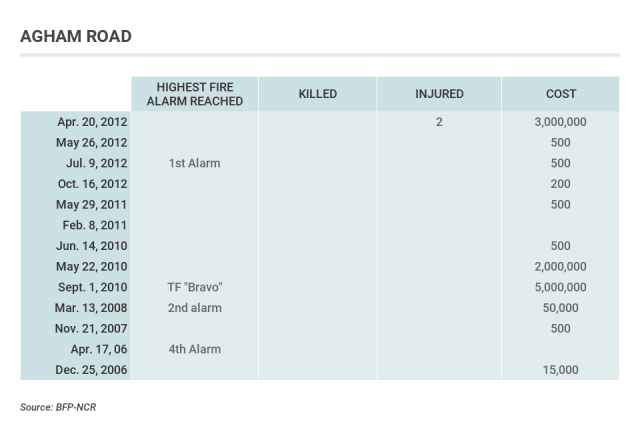
Data from the Bureau of Fire Protection show that one of the usual causes of fires in these areas are overloading of electrical outlets.
Kent Faminial, barangay chair of Addition Hills, said the common causes of fire in Welfareville are LPG leakage and unattended candles.
BFP-NCR Director Senior Supt. Rico Neil Kwan Tiu pointed to illegal electrical connection.
Kwan Tiu said the lack of order in these communities greatly contributes to making them fire-prone.
“Very rampant ang lack of discipline sa mga lugar na ito. Nagiging pabaya, reckless. Mga pasaway yung mga tao sa komunidad. Minsan nga may mga nagtatapon pa ng gasera,” Kwan Tiu said.
But Cagay of Center for Disaster Preparedness said the government should be put to task for failing to ensure safety in these communities.
“Kung may pagkakataon ang mga tao at may oportunidad na makapili ng tirahang ligtas, sigurado kami na hindi titira sa ganoong mga lugar ang mga pamilyang ito,” Cagay said.
“Mahihirap na lugar ang mga ito kaya mataas ang safety risk dito. Yung kuryente nila makikita yong nag-spaghetti, dikit-dikit," she added.
"Ang mga bahay patung- patong. Di katulad sa mga subidivision na puwedeng mayroong nakahandang mga shelter plan in case of disaster,” Cagay said.
Cagay said local governments should devise a sound zoning plan for its residents.
Cagay said Republic Act 10121 or the Philippine Disaster Risk Reduction and Management Act of 2010 also states that the LGUs should have a contingency plan in case of fires and other disasters.
The law has a penal provision, prohibiting certain acts including dereliction of duties which leads to destruction and death.
Violators can be fined from P50,000 to P500,000 and/or jailed for six to 12 years or perpetually disqualified from public office.
But Kwan Tiu said that some LGUs already have begun improvements in the fire-prone areas.
The Mandaluyong City government, for one, is planning to help Welfareville residents construct concrete houses and install proper electric power lines. —with a report from Sandra Aguinaldo/NB, GMA News



